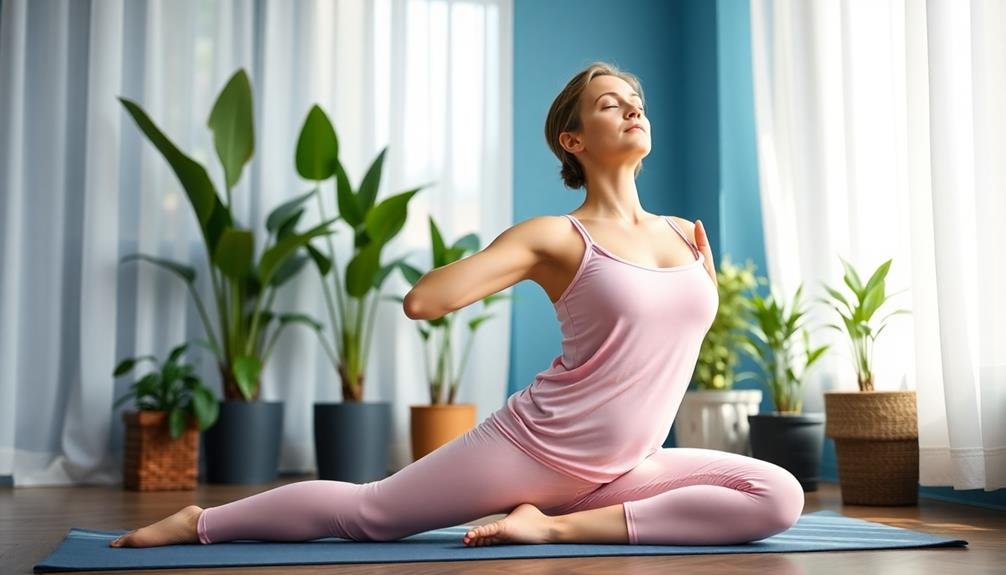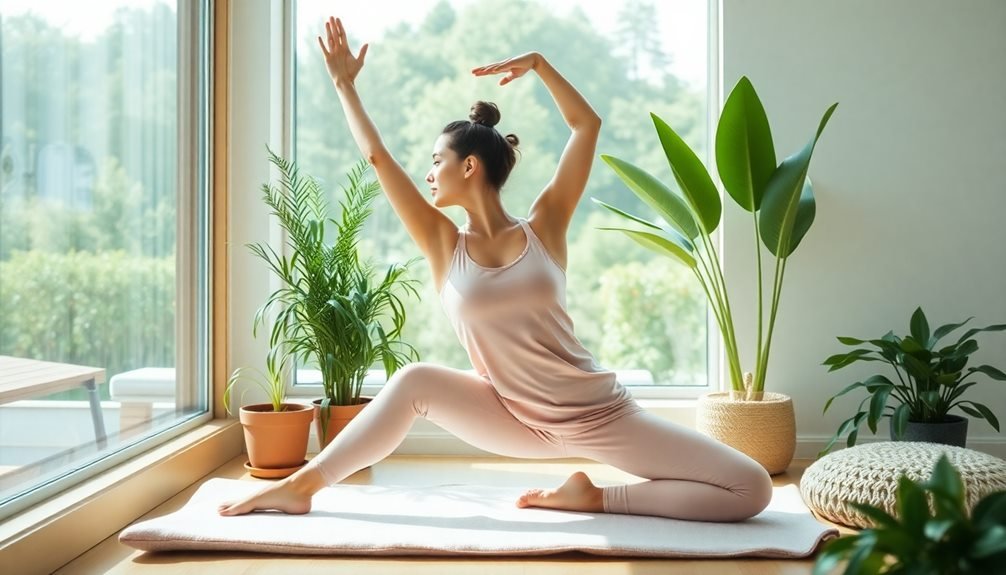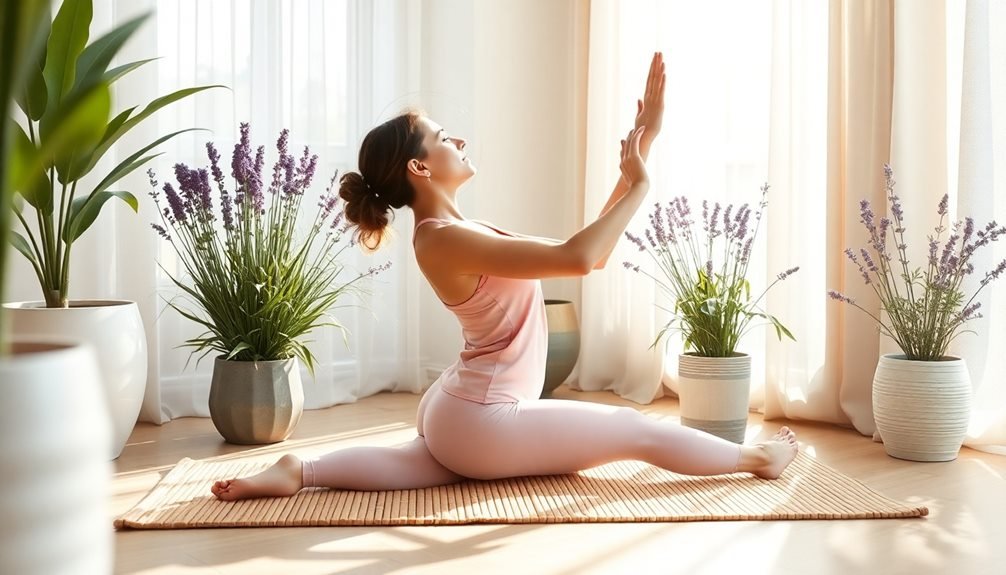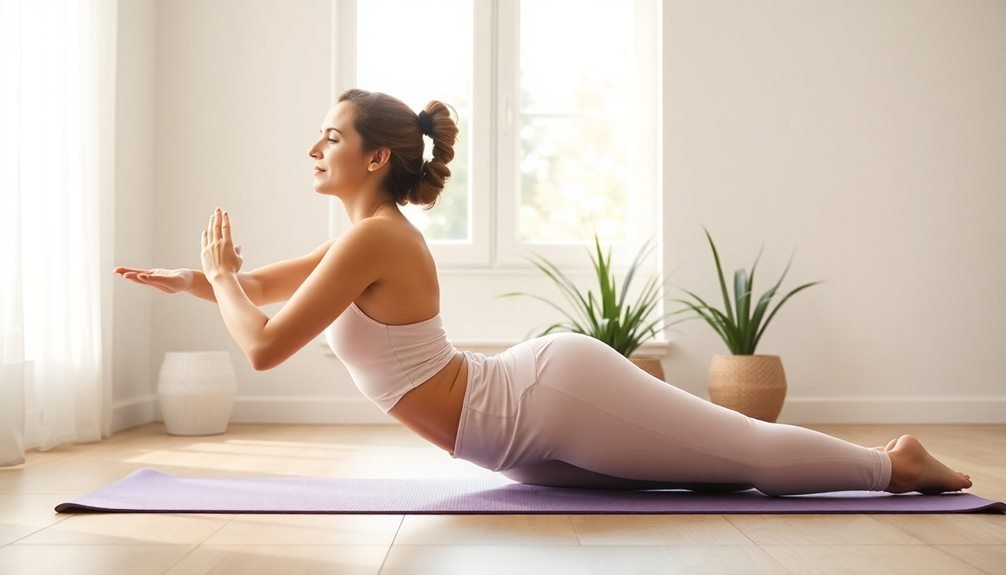Gentle yoga eases your anxious mind by activating your body's relaxation response. As you move through poses and focus on your breath, you're engaging in mindfulness that breaks the cycle of anxious thoughts. The practice calms your nervous system, reducing stress hormones and promoting the release of mood-enhancing endorphins. You'll improve body awareness, helping you recognize and release tension. Regular gentle yoga can enhance sleep quality, boost self-confidence, and provide a sense of grounding. It's not just about the physical benefits; yoga cultivates self-compassion and acceptance. By incorporating props and creating a calming space, you'll deepen your practice and its anxiety-relieving effects.
Key Takeaways
- Gentle yoga activates the parasympathetic nervous system, promoting relaxation and reducing anxiety.
- Regular practice improves body awareness, helping identify and release tension associated with anxiety.
- Mindful focus on breath and poses breaks the cycle of anxious thoughts, cultivating present-moment awareness.
- Yoga reduces stress hormones while releasing endorphins, enhancing mood and overall well-being.
- Restorative poses and extended holds quiet the mind and alleviate stress, fostering a sense of calm.
Understanding Anxiety and Yoga Connection

Turmoil plagues millions of minds daily, but yoga offers a beacon of hope. Anxiety, a pervasive mental health issue, manifests as persistent worry, restlessness, and physical tension. It's your body's natural response to stress, but when it becomes chronic, it can considerably impact your quality of life.
Enter yoga, an ancient practice that combines physical postures, breathwork, and meditation. It's not just about flexibility; yoga directly addresses the mind-body connection that's essential in managing anxiety. When you practice gentle yoga, you're engaging in a form of moving meditation that helps calm your nervous system.
The connection between yoga and anxiety relief lies in its ability to activate your parasympathetic nervous system, responsible for the "rest and digest" response. This counteracts the "fight or flight" mode often triggered by anxiety. Through controlled breathing and mindful movement, you're training your body to respond differently to stress triggers.
Moreover, yoga encourages mindfulness, helping you stay present and break the cycle of anxious thoughts. It's a powerful tool that empowers you to regain control over your mental state.
Benefits of Gentle Yoga Practice

Embracing a gentle yoga practice can yield numerous benefits for those grappling with anxiety. You'll find that regular practice helps calm your nervous system, reducing the frequency and intensity of anxious thoughts.
As you focus on your breath and move through gentle poses, you'll cultivate mindfulness, anchoring yourself in the present moment rather than worrying about the future.
Gentle yoga improves your body awareness, helping you recognize tension and release it consciously. This skill translates off the mat, enabling you to manage stress more effectively in daily life.
You'll also experience improved sleep quality, as the relaxation techniques learned in yoga can ease you into a restful state.
The practice enhances your flexibility and strength, boosting your overall physical health and self-confidence. As you progress, you'll develop a sense of accomplishment and self-efficacy, which can counteract feelings of helplessness often associated with anxiety.
Additionally, gentle yoga fosters a supportive community, providing a sense of connection and shared experience. This social aspect can be particularly beneficial in combating the isolation that anxiety sometimes breeds.
Breath-Focused Poses for Calmness

Several breath-focused poses can considerably calm an anxious mind. These gentle yoga postures emphasize deep, rhythmic breathing to soothe your nervous system and promote relaxation.
One effective pose is the seated forward fold, where you'll sit with legs extended, inhale deeply, and exhale as you bend forward, focusing on your breath.
Another calming pose is cat-cow, which synchronizes breath with movement. As you inhale, arch your back and lift your chest; as you exhale, round your spine and tuck your chin.
The child's pose is also excellent for anxiety relief. Kneel on the floor, sit back on your heels, and extend your arms forward. As you breathe deeply, feel the tension leave your body.
For a more restorative option, try legs-up-the-wall pose. Lie on your back with your legs extended up a wall, breathing slowly and deliberately.
Grounding Techniques in Yoga

Grounding techniques in yoga can help anchor your mind and body in the present moment, reducing anxiety and promoting a sense of stability. These practices often involve connecting with the earth and focusing on physical sensations to calm your racing thoughts.
One effective grounding technique is the Mountain Pose (Tadasana). Stand with your feet hip-width apart, feeling the floor beneath you. Spread your toes and distribute your weight evenly. Engage your leg muscles and lengthen your spine. As you breathe deeply, imagine roots growing from your feet into the earth, stabilizing you.
Another grounding practice is the Body Scan. Lie on your back in Corpse Pose (Savasana) and systematically focus on each part of your body, starting from your toes and moving upward. Notice any sensations without judgment, allowing tension to release as you bring awareness to each area.
You can also try the 5-4-3-2-1 technique during your practice. Name five things you can see, four things you can touch, three things you can hear, two things you can smell, and one thing you can taste. This exercise helps redirect your attention to your immediate surroundings, grounding you in the present.
Restorative Poses for Stress Relief

Restorative poses offer a powerful way to alleviate stress and calm an anxious mind. These gentle postures allow you to relax deeply, releasing tension from your body and quieting your thoughts. By holding supported positions for extended periods, you'll activate your parasympathetic nervous system, triggering the body's natural relaxation response.
Start with Child's Pose, resting your forehead on the mat and extending your arms forward. This pose helps you feel grounded and protected.
Next, try Legs-Up-the-Wall pose, which reverses blood flow and promotes a sense of calm. For a gentle chest opener, lie on your back with a bolster supporting your spine, allowing your arms to rest at your sides.
Supported Forward Fold is another excellent restorative pose. Sit on a folded blanket with your legs extended, then fold forward over a bolster or cushions. This pose encourages introspection and releases tension in your back and hamstrings.
Mindfulness Through Gentle Movements

Gentle yoga movements can cultivate mindfulness by anchoring your attention to the present moment.
As you flow through poses, you'll strengthen the connection between your body and mind, becoming more attuned to physical sensations and thoughts.
Present-Moment Awareness
Awareness forms the foundation of mindfulness in gentle yoga practice. As you move through poses, you're encouraged to focus on the present moment, letting go of worries about the past or future. This heightened awareness helps you connect with your body, breath, and surroundings, reducing anxiety and promoting a sense of calm.
During gentle yoga, you'll practice present-moment awareness through various techniques:
| Technique | Benefits |
|---|---|
| Body scanning | Increases body awareness |
| Breath focus | Calms the nervous system |
| Sensory attention | Grounds you in the present |
| Mindful movement | Improves mind-body connection |
Body-Mind Connection
Building on present-moment awareness, the body-mind connection takes mindfulness a step further through gentle movements. As you practice gentle yoga, you'll notice how your body responds to different poses and breathing exercises. This heightened awareness helps you recognize the intricate link between your physical sensations and emotional state.
You'll learn to tune into subtle cues your body sends, like tension in your shoulders or a knot in your stomach. These physical manifestations often reflect underlying stress or anxiety. By acknowledging these sensations without judgment, you can begin to address their root causes.
Gentle yoga encourages you to move mindfully, focusing on each stretch and breath. This deliberate approach strengthens the body-mind connection, allowing you to better regulate your emotions and stress responses. You'll discover how slowing down your movements can calm your racing thoughts and soothe your anxious mind.
As you continue to practice, you'll develop a deeper understanding of your body's needs and limitations. This self-awareness extends beyond the yoga mat, empowering you to make more informed choices about your overall well-being and manage anxiety more effectively in daily life.
Breath-Centered Practice
Centered on the breath, a mindful yoga practice offers a powerful tool for managing anxiety. As you move through gentle poses, you'll focus on your breathing, creating a natural rhythm that calms your nervous system. This breath-centered approach helps you stay present, anchoring your mind to the here and now instead of spiraling into worry about the future.
You'll learn to synchronize your movements with your breath, inhaling as you extend or open your body, and exhaling as you contract or fold. This coordination cultivates a deep mind-body connection, helping you become more aware of physical sensations and emotional states.
As you practice, you'll notice how your breath affects your body and mind, giving you greater control over your anxiety responses.
Breath-centered yoga also teaches you valuable techniques you can use off the mat. When anxiety strikes, you'll have tools like deep belly breathing or alternate nostril breathing at your disposal.
These practices can quickly shift your body from a state of stress to one of relaxation, empowering you to manage anxiety more effectively in your daily life.
Yoga Props for Relaxation

You'll find that incorporating yoga props can greatly enhance your relaxation practice.
Essential support tools like bolsters, blocks, and straps can help you maintain proper alignment and comfort during gentle poses.
These accessories allow you to fully release tension and sink deeper into restorative postures, making your yoga practice more effective for calming an anxious mind.
Essential Relaxation Support Tools
To enhance your gentle yoga practice and promote relaxation, having the right props on hand can make a significant difference. A yoga mat is your foundation, providing cushioning and grip for various poses. Opt for a thicker mat if you need extra joint support.
Bolsters are essential for restorative poses, offering comfort and support for your spine and limbs. They're particularly useful in heart-opening poses and seated forward bends.
Blankets serve multiple purposes: they can be folded for extra height, used as cushioning, or draped over you during final relaxation.
Blocks help bring the floor closer to you, making poses more accessible and allowing for proper alignment. Straps assist in deepening stretches and maintaining proper form, especially in seated poses or when working on flexibility.
An eye pillow can be incredibly soothing during relaxation poses, blocking out light and providing gentle pressure on your eyes.
Comfort-Enhancing Yoga Accessories
Beyond the basic yoga props, several comfort-enhancing accessories can elevate your relaxation practice. A supportive eye pillow can block out light and provide gentle pressure, promoting deeper relaxation during savasana.
Weighted blankets offer a comforting, grounding sensation that can calm your nervous system and reduce anxiety.
Consider adding aromatherapy to your practice with essential oil diffusers or scented eye pillows. Lavender, chamomile, and sandalwood are particularly soothing scents that can enhance your relaxation experience.
A small speaker for calming music or guided meditations can help you maintain focus and create a serene atmosphere.
Don't overlook the importance of comfortable, breathable clothing. Opt for loose-fitting, soft fabrics that won't restrict your movement or distract you during your practice.
A cozy wrap or shawl can provide warmth and comfort during slower, more restorative poses.
Creating a Calming Practice Space

Nestled within your home, a tranquil yoga space can become a sanctuary for your anxious mind. To create this calming environment, consider the elements that soothe your senses. Choose soft, warm lighting or natural sunlight to set a peaceful mood. Incorporate calming colors like soft blues, greens, or neutrals to promote relaxation.
Keep your practice area clutter-free and organized. A tidy space helps clear your mind and allows you to focus on your yoga practice. Include natural elements like plants or a small indoor water fountain to bring a sense of serenity to your surroundings.
Consider these essentials for your calming practice space:
- A dedicated yoga mat or cushioned area
- Soft blankets or bolsters for comfort
- Aromatherapy diffuser with calming essential oils
- Soothing background music or nature sounds
Gentle Sequences for Beginners

With your calming practice space set up, you're ready to start your gentle yoga journey. Begin with a simple seated pose, focusing on your breath. Inhale deeply through your nose, and exhale slowly through your mouth. Repeat this for a few minutes, allowing your mind to settle.
Next, try a gentle cat-cow stretch. On your hands and knees, arch your back as you inhale, then round it as you exhale. This helps release tension in your spine and shoulders.
Move on to child's pose, stretching your arms forward while sitting back on your heels. It's a comforting position that can help calm your mind.
For a standing sequence, try mountain pose. Stand tall, feet hip-width apart, and feel grounded. Raise your arms overhead on an inhale, then lower them on an exhale.
Follow this with a gentle forward fold, letting your upper body hang loose.
Finish with a simple twist. Sit cross-legged, place your right hand on your left knee, and gently twist to the left. Hold for a few breaths, then switch sides.
Incorporating Meditation Into Yoga

Meditation and yoga go hand in hand, enhancing each other's benefits for anxious minds. As you practice gentle yoga, you'll find numerous opportunities to incorporate meditation techniques.
Start by focusing on your breath during poses, allowing your mind to settle and become present. This mindful approach helps quiet racing thoughts and reduces anxiety.
To deepen your practice, try integrating short meditation sessions at the beginning or end of your yoga routine. Close your eyes, sit comfortably, and observe your thoughts without judgment. This cultivates awareness and emotional regulation, key skills for managing anxiety.
Here are four ways to incorporate meditation into your yoga practice:
- Use guided visualizations during relaxation poses
- Practice mindful breathing between asanas
- Set intentions at the start of your session
- End with a body scan meditation
Yoga for Better Sleep

Anxiety often disrupts sleep patterns, creating a vicious cycle of stress and fatigue. Gentle yoga can help break this cycle by promoting relaxation and preparing your body for restful sleep. By practicing specific yoga poses before bed, you'll calm your nervous system and release tension accumulated throughout the day.
Try incorporating poses like Child's Pose, Legs-Up-the-Wall, and Reclined Bound Angle Pose into your nighttime routine. These gentle postures encourage deep breathing and promote a sense of grounding. As you hold each pose, focus on slow, deliberate breaths to quiet racing thoughts.
You can also practice gentle stretches while lying in bed. Simple neck rolls, shoulder shrugs, and ankle rotations help release muscle tension and signal to your body that it's time to wind down.
Pair these movements with conscious breathing exercises, like the 4-7-8 technique, to further induce relaxation.
Consistency and Self-Compassion in Practice

Establishing a consistent yoga practice is key to reaping its anxiety-reducing benefits, but it's equally important to approach your routine with self-compassion.
Set realistic goals for your practice, aiming for regularity rather than perfection. Even if you can only manage a few minutes daily, consistency will yield more benefits than sporadic longer sessions.
Remember, yoga isn't about achieving perfect poses or competing with others. It's a personal journey of self-discovery and growth.
Be kind to yourself when you struggle or miss a day. Instead of self-criticism, use these moments as opportunities to practice mindfulness and self-acceptance.
To cultivate self-compassion in your yoga practice:
- Listen to your body and respect its limits
- Celebrate small improvements and efforts
- Use positive self-talk during challenging poses
- Focus on how you feel rather than how you look
Frequently Asked Questions
Can Gentle Yoga Replace Medication for Anxiety Disorders?
You shouldn't replace anxiety medication with gentle yoga without consulting your doctor. While yoga can help manage symptoms, it's not a substitute for prescribed treatments. It's best to use yoga as a complementary practice alongside medical advice.
How Long Does It Take to See Results From Gentle Yoga Practice?
You'll likely notice some benefits from gentle yoga within a few weeks of regular practice. However, it's different for everyone. Stick with it consistently, and you may experience reduced anxiety and improved well-being in 1-3 months.
Is Gentle Yoga Suitable for People With Physical Limitations or Injuries?
Yes, gentle yoga is ideal if you're dealing with physical limitations or injuries. You can modify poses to suit your needs, and it's low-impact. Always consult your doctor first and listen to your body during practice.
Can Children Practice Gentle Yoga for Anxiety Relief?
Yes, children can practice gentle yoga for anxiety relief. You'll find it's a great way to help kids manage stress. They'll learn breathing techniques, simple poses, and mindfulness skills that can calm their minds and improve their overall well-being.
Are There Any Potential Risks or Side Effects of Practicing Gentle Yoga?
You'll find gentle yoga is generally safe, but you should be aware of potential risks. You might experience muscle soreness, strain, or injury if you push too hard. Always listen to your body and consult a doctor if you're unsure.
In Summary
You've discovered the power of gentle yoga to soothe your anxious mind. By embracing breath-focused poses, grounding techniques, and restorative practices, you're giving yourself a valuable tool for stress relief. Remember, consistency is key, but be patient with yourself. As you incorporate meditation and develop a regular practice, you'll likely notice improvements in your sleep and overall well-being. Keep nurturing this connection between body and mind—it's your path to inner calm.





Leave a Reply